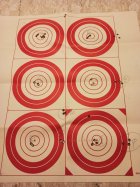Hi to all,
i shoot, on my new remington 700 308 win, using the N140 powder and Lapua scenar-l 175 this targets, to find the right node. The load start from 39.3 up to 42, FM210G as primer, using 2.937 as COAL, just -0.020 from the jump.
I think that the shots from 7 to 10 could be the node, all are at the same height, the shots are done with 41.1 to 42 grn of N140.
I think to start from the 8 (41.4/41.5) fine adjusting the seating depth from -0.010 to -0.040 like Erik Cortina says.
Do you think, like me, that the groups from the 7 to 10 are consistent or i'm wrong and the node is another?
Thanks.
Cris.
i shoot, on my new remington 700 308 win, using the N140 powder and Lapua scenar-l 175 this targets, to find the right node. The load start from 39.3 up to 42, FM210G as primer, using 2.937 as COAL, just -0.020 from the jump.
I think that the shots from 7 to 10 could be the node, all are at the same height, the shots are done with 41.1 to 42 grn of N140.
I think to start from the 8 (41.4/41.5) fine adjusting the seating depth from -0.010 to -0.040 like Erik Cortina says.
Do you think, like me, that the groups from the 7 to 10 are consistent or i'm wrong and the node is another?
Thanks.
Cris.












